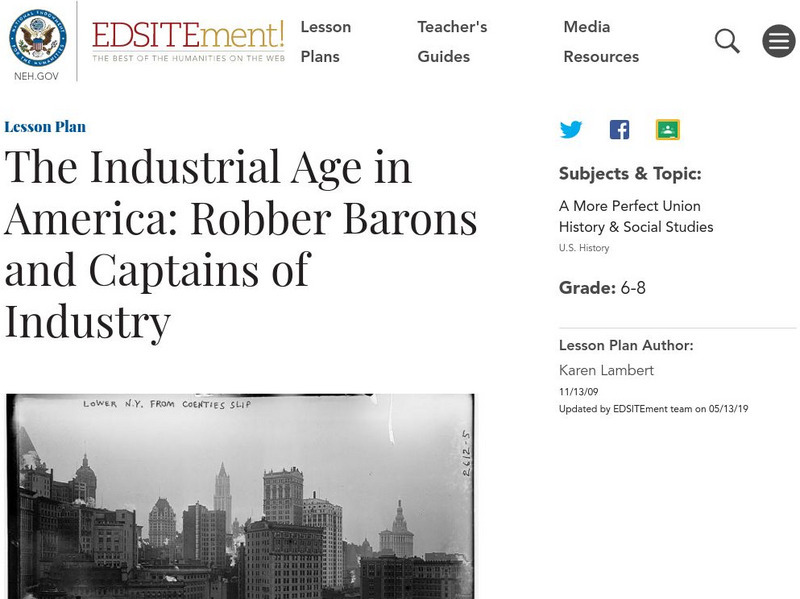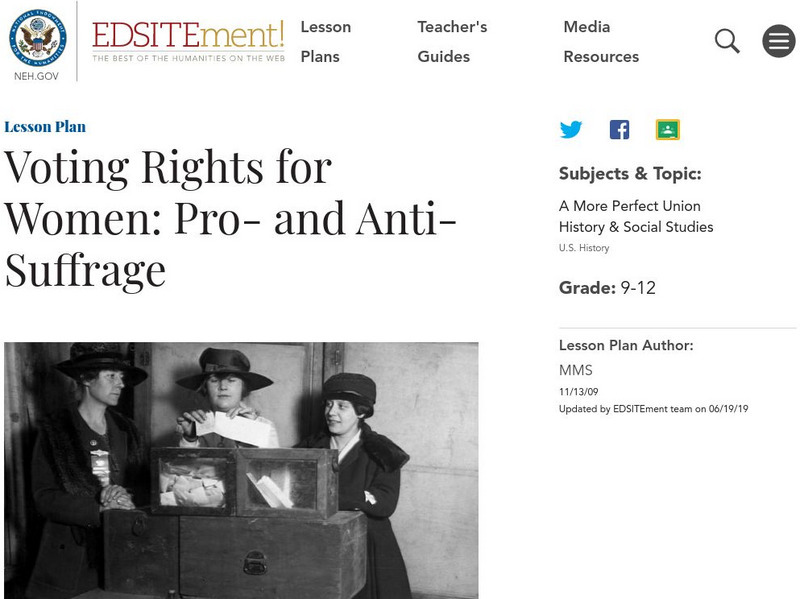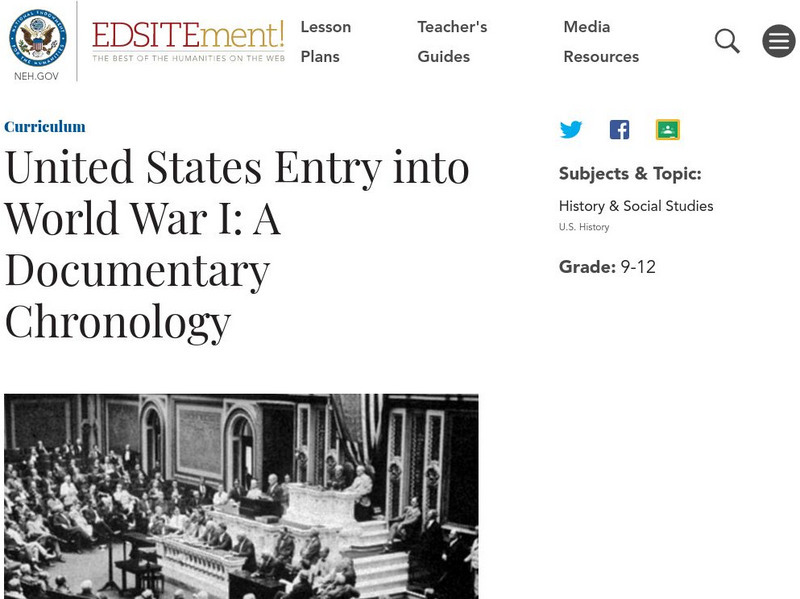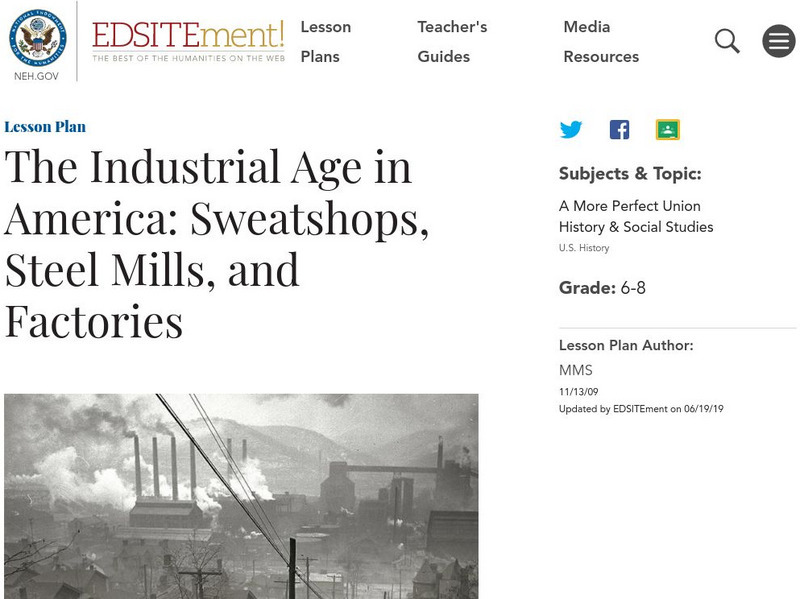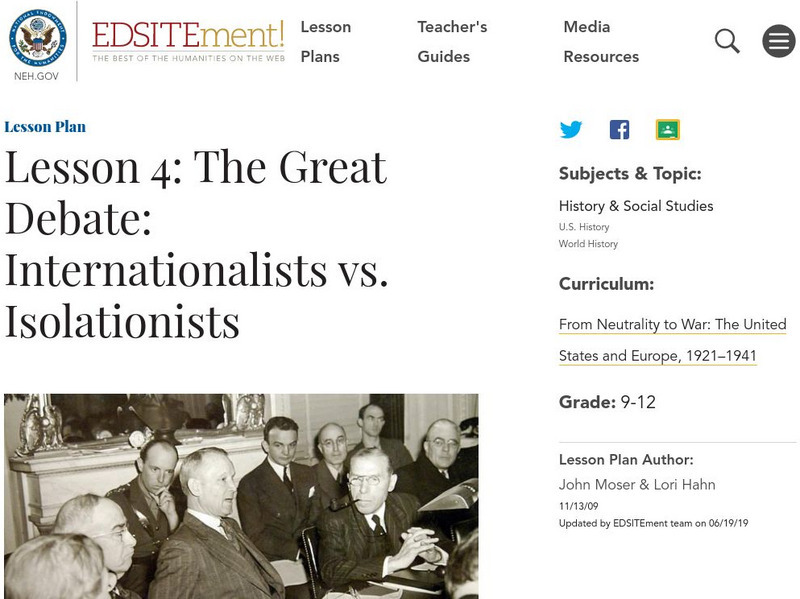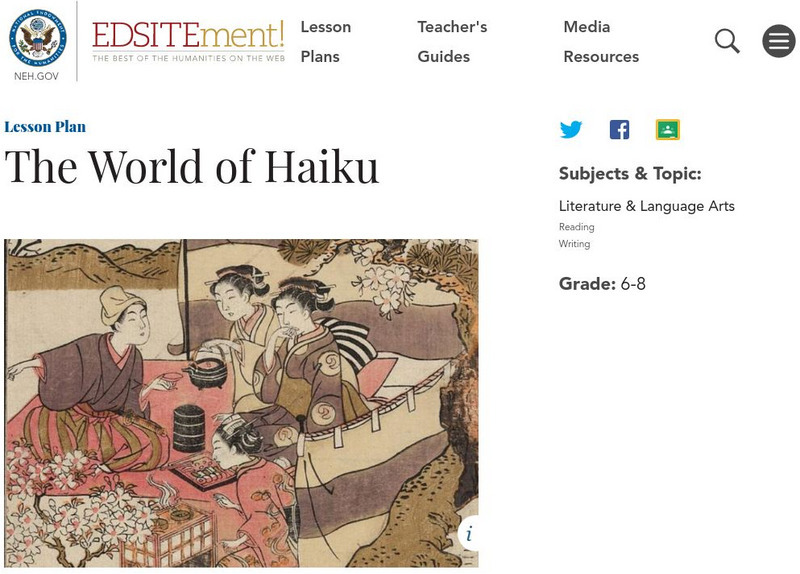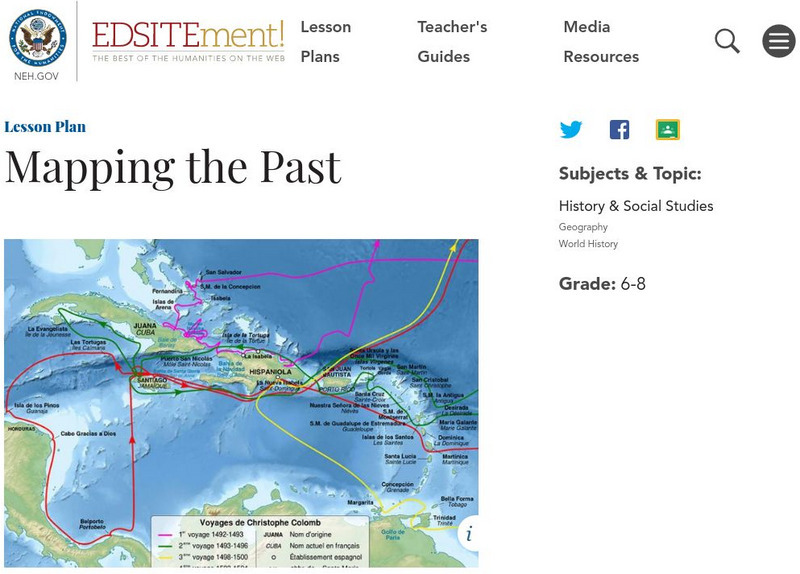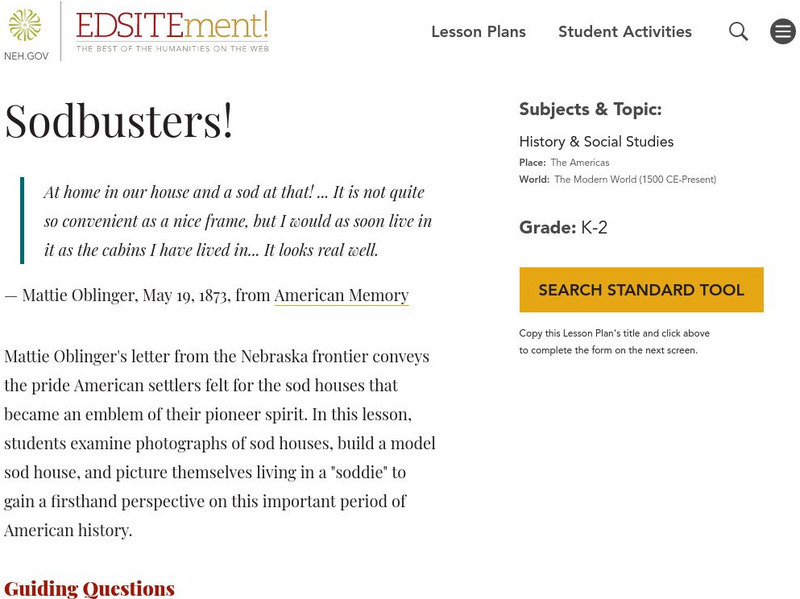Hi, what do you want to do?
Curated OER
Country: Africa
Learners access a variety of Africa themed websites. They locate information about African people, governments, languages and culture. They interact with timelines and explore African history or art.
National Endowment for the Humanities
Neh: Edsit Ement: Robber Barons and Captains of Industry
A very thorough lesson plan from EDSITEment that explores the role of the robber barons in American industry in the 19th century. It explores the question of whether the robber barons were harmful or "Captains of Industry." You'll find...
National Endowment for the Humanities
Neh: Edsit Ement: Voting Rights for Women: Pro and Anti Suffrage
This website from EDSITEment has a lesson plan that examines the push and pushback for voting rights for women. Using primary sources such as political cartoons and letters, find out why people were opposed to universal suffrage, and...
National Endowment for the Humanities
Neh: Edsit Ement: The Campaign of 1840
A three-lesson unit on the campaign and election of 1840. Links to many sites for more information, interactive worksheets, lesson objectives, and assessment. From EDSITEment.
National Endowment for the Humanities
Neh: Edsit Ement: United States Entry Into World War I: A Documentary Chronology
EDSITEment offers unit with three lessons that examines the views of whether the U.S. should enter World War I, the reasons for entering the war, and a chronololgy of events that led up to the U.S. entry to the war. A complete plan with...
National Endowment for the Humanities
Neh: Edsit Ement: Was There an Industrial Revolution?
This lesson plan from EDSITEment discusses the actual factors leading to the Industrial Revolution in the post-civil war era. Contains many links to primary source materials.
National Endowment for the Humanities
Neh: Edsit Ement: I'm Gonna Sit Right Down and Write Someone a Letter
Through the vast online resources available from EDSITEment, students can read the correspondence of the famous, the infamous and the ordinary, some of whom lived through extraordinary times. Use these fascinating letters as a starting...
National Endowment for the Humanities
Neh: Edsit Ement: Animals of the Chinese Zodiac
This site from EDSITEment provides a fun look at the Chinese culture by examining the animals of the Chinese Zodiac and the traits of the Chinese calendar.
National Endowment for the Humanities
Neh: Edsit Ement: The Industrial Age in America
In this lesson plan from EDSITEment, students will discuss the significance of the labor movement, the industrialists involved and the attitude of the American people toward working conditions in the United States. Contains links to many...
National Endowment for the Humanities
Neh: Edsit Ement: The Great Debate: Internationalists vs. Isolationists
This great lesson plan from EDSITEment uses primary sources, an interactive timeline, and guiding questions to examine the debate in the United States over the merits of isolationism vs. internationalism after the passage of the...
National Endowment for the Humanities
Neh: Edsit Ement: Woodrow Wilson and Foreign Policy
A thorough review of Woodrow Wilson's foreign policies in these four lessons offered by EDSITEment. Learn the origins of "Wilsonianism," Wilson's views on relations with countries in Latin America, Wilson's decision to enter World War I,...
National Endowment for the Humanities
Neh: Edsit Ement: The Emancipation Proclamation: Freedom's First Steps
By reading and studying a variety of written resources--the Emancipation Proclamation and newspaper archives--high school students explore the steps Lincoln took towards emancipating the slaves and freed slaves' reaction to the...
National Endowment for the Humanities
Neh: Edsit Ement: All Together Now: Collaborations in Poetry Writing
Three learning activities to teach K-2 students about poetry. Very detailed lessons with references and other suggested activities. Ways to individualize and academic content standards are noted. (Attachment may not load in archived URL.)
National Endowment for the Humanities
Neh: Edsit Ement: Writing Poetry Like Pros
By looking to examples of popular poetry in a variety of forms, students learn to analyze, appreciate, and synthesize poetry in the classroom. "Writing Poetry Like Pros" provides several links to poetry texts and suggestions for creating...
National Endowment for the Humanities
Neh: Edsit Ement: The World of Haiku
A productive, technologically relevant site that provides a lesson plan on the Japanese Haiku. Complete with educational objectives and extensive student-centered lesson development.
National Endowment for the Humanities
Neh: Edsit Ement: Anishinabe Ojibwe Chippewa: Culture
Though written for grades 3-5, this lesson plan can be easily changed to help students of all ages learn about the Chippewa people. Additional resources provide historical, cultural, and geographical facts concerning this Native American...
National Endowment for the Humanities
Neh: Edsit Ement: Before Brother Fought Brother
A lesson plan that addresses the "complex series of events" leading to the Civil War. Through this lesson, students will "gain an appreciation of everyday life in the North and South, changes occurring, and some of the major social and...
National Endowment for the Humanities
Neh: Edsit Ement: Learning the Blues
This lesson plan introduces young scholars to the blues. The origin and development of the blues is explored as well as its distinctive structure.
National Endowment for the Humanities
Neh: Edsit Ement: Mapping the Past
This lesson plan requires the students to examine past maps from various cultures in order to learn how the people from that time period interacted and understood their world.
National Endowment for the Humanities
Neh: Edsit Ement: Sodbusters!
From the National Endowment for the Humanities, a lesson plan on sod construction on the American prairie, "Sodbusters!" includes several links to related information and four activities: "Designing a Home," "Sodbusters and Their Homes,"...
National Endowment for the Humanities
Neh: Edsit Ement: Fear and the "Dagger of the Mind"
This lesson plan accompanies a reading of Shakespeare's Macbeth and lets students explore Macbeth's "response to fear" through studying metaphor, imagery, and dramatic cues and by performing a scene.
National Endowment for the Humanities
Neh: Edsit Ement: The Alphabet Is Historic
Great lesson plans for grades K-2 on the history of the alphabet. Includes guiding question, objectives, and four lessons with activities and assessments. With links to various websites containing information on alphabet history.
National Endowment for the Humanities
Neh: Edsit Ement: The "Secret Society" and Fitzgerald's "The Great Gatsby"
Excellent and detailed lesson on Fitzgerald's Great Gatsby. Discusses and includes higher-level thinking skills such as the desire to belong, with relevance to students.
National Endowment for the Humanities
Neh: Edsit Ement: Analyzing Poetic Devices: Robert Hayden and Theodore Roethke
Students examine the relationship of poetic form and content, shaped by alliteration, consonance, repetition, and rhythm, in two poems about fatherhood: Robert Hayden's "Those Winter Sundays" and Theodore Roethke's "My Papa's Waltz."






